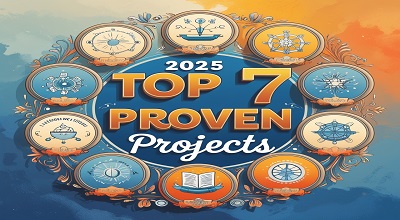Top 7 Proven Projects Teachers Swear By
Top 7 Proven Projects Teachers Swear By: Teachers are always on the lookout for innovative and effective projects to engage students and enhance learning. Whether it’s STEM activities, creative arts, or collaborative assignments, the right project can make a significant difference in the classroom. In this blog post, we’ll explore seven teacher-approved projects that have proven successful in modern education.
From hands-on experiments to digital collaborations, these projects cater to different subjects and grade levels, ensuring that every educator finds something valuable. Let’s dive in!
STEM: Building a Mini Solar-Powered Car
Why Teachers Love It?
STEM (Science, Technology, Engineering, and Mathematics) projects are essential for fostering critical thinking and problem-solving skills. Building a mini solar-powered car is a fantastic way to introduce students to renewable energy and basic engineering concepts.
How to Implement It?
- Materials Needed: Small solar panels, DC motor, wheels, lightweight chassis (cardboard or plastic), wires, and glue.
- Steps:
- Design the car structure.
- Connect the solar panel to the motor.
- Assemble the wheels and test under sunlight.
- Learning Outcomes: Understanding solar energy, circuitry, and mechanical design.
Pro Tip: Have students compete to see whose car travels the fastest or farthest!
Creative Writing: Collaborative Storytelling with Google Docs
Why Teachers Love It?
Collaborative storytelling enhances creativity and teamwork. Using Google Docs, students can co-write stories in real-time, improving their writing and editing skills.
How to Implement It?
- Assign small groups and provide a story prompt.
- Each student contributes a paragraph, building on the previous one.
- Use the “Suggesting” mode for peer editing.
- Bonus: Turn the best stories into a class anthology.
Pro Tip: Incorporate multimedia by having students add illustrations or audio narrations.
History: Virtual Museum Exhibit
Why Teachers Love It?
Instead of traditional reports, students create a virtual museum exhibit using tools like Google Slides or Canva. This project encourages research, design skills, and public speaking.
How to Implement It?
- Assign historical topics (e.g., Ancient Egypt, World War II).
- Students curate “artifacts” (images, videos, descriptions).
- Present exhibits to the class in a “museum walk.”
Pro Tip: Use Padlet or Wakelet for interactive displays.
Math: Budgeting a Dream Vacation
Why Teachers Love It?
This real-world math project teaches financial literacy and percentage calculations as students plan a dream vacation within a budget.
How to Implement It?
- Give students a fixed budget (e.g., $3,000).
- They research flights, hotels, activities, and food costs.
- Use spreadsheets to track expenses and adjust plans.
Pro Tip: Add exchange rate calculations for international trips.
Science: DIY Water Filtration System?
Why Teachers Love It?
Environmental science comes alive with a DIY water filtration project. Students learn about pollution and clean water solutions.
How to Implement It?
- Materials: Plastic bottles, sand, gravel, cotton, activated charcoal.
- Test dirty water before and after filtration.
- Discuss real-world applications (e.g., water scarcity).
Pro Tip: Compare different filtration methods for effectiveness.
Art: Stop-Motion Animation
Why Teachers Love It?
Stop-motion combines art and technology, allowing students to express creativity while learning basic animation principles.
How to Implement It?
- Use free apps like Stop Motion Studio.
- Students create characters from clay or paper.
- Film frame-by-frame and edit with sound effects.
Pro Tip: Host a class film festival for finished projects.
Social Studies: Mock United Nations Debate?
Why Teachers Love It?
A Mock UN debate teaches diplomacy, research, and public speaking. Students represent countries and debate global issues.
How to Implement It?
- Assign countries and topics (e.g., climate change).
- Research positions and draft resolutions.
- Hold a formal debate with voting.
Pro Tip: Record sessions for reflection and improvement.
FAQs
1. How do I adapt these projects for different grade levels?
- Simplify steps for younger students (e.g., fewer variables in the solar car project).
- Increase complexity for older students (e.g., advanced research in Mock UN debates).
2. What if I don’t have access to high-tech tools?
Many projects (like water filtration or storytelling) require minimal tech. Use low-cost alternatives when possible.
3. How can I assess student performance in these projects?
Use rubrics focusing on creativity, collaboration, and subject mastery. Peer reviews also work well.
4. Can these projects be done remotely?
Yes! Tools like Google Docs, Zoom, and digital whiteboards support virtual collaboration.
5. Where can I find more teacher-approved project ideas?
Check out TeacherEducator.com for lesson plans, templates, and expert tips.
Conclusion
These seven teacher-approved projects are designed to engage students across subjects while fostering essential skills. Whether you’re teaching STEM, arts, or social studies, there’s an innovative project here for your classroom.
